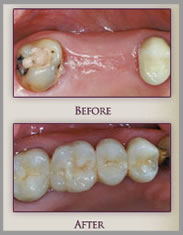Dental Bridges
.A bridge may be recommended if you're missing
one or more teeth. Gaps left by missing teeth eventually cause
the remaining teeth to rotate or shift into the empty spaces,
resulting in a bad bite. The imbalance caused by missing teeth
can also lead to gum disease and temporomandibular joint (TMJ)
disorders.
 One
or more missing teeth can adversely affect the appearance
and functionality of your smile. Missing teeth can cause a
change in occlusion (bite), shifting of the teeth, temporomandibular
joint disorder (TMJ), speech impediments, an increased risk
for periodontal disease and a greater chance of tooth decay. One
or more missing teeth can adversely affect the appearance
and functionality of your smile. Missing teeth can cause a
change in occlusion (bite), shifting of the teeth, temporomandibular
joint disorder (TMJ), speech impediments, an increased risk
for periodontal disease and a greater chance of tooth decay.
Dental bridges, like implants and partial dentures, are used
to replace missing teeth. There are several types of fixed
dental bridges (cannot be removed), including conventional
fixed bridges, cantilever bridges and resin-bonded bridges.
Typically, conventional and cantilever bridges require shaping
of the teeth surrounding a missing tooth. Crowns are then
placed on the shaped teeth and attached to an artificial tooth
(called a pontic).
A resin-bonded bridge requires less preparation of adjacent
teeth. It is often used to replace front teeth, provided that
the gums are healthy and the surrounding teeth do not have
extensive dental fillings.
The Dental Bridge Procedure
During the first visit, our dentist examines the health
of your gums and other teeth to evaluate if you are a candidate
for a dental bridge. If you are a candidate for a dental bridge,
you are given a local anesthetic so your dentist can prepare
the teeth required to support the bridge. If the support teeth
are decayed or badly broken down, your dentist may have to
build them back up before they can be used as support teeth
for a bridge.
Next, your dentist takes an impression of the prepared teeth
with a putty-like material that is used to create a model
of your teeth. Your bridge is fabricated based on this model
by a skilled lab technician so that it precisely fits the
prepared teeth. It is important that your restoration fit
perfectly to avoid additional oral health problems such as
tooth decay.
While your bridge is being fabricated, your dentist fits
you with a temporary bridge so the teeth and gums can be protected
from damage until your permanent bridge is ready.
To complete the dental bridge procedure, you must return
to the dental office for a second visit to have the bridge
fitted and cemented.
back to top
|





